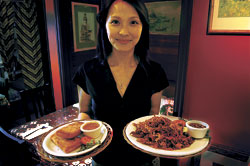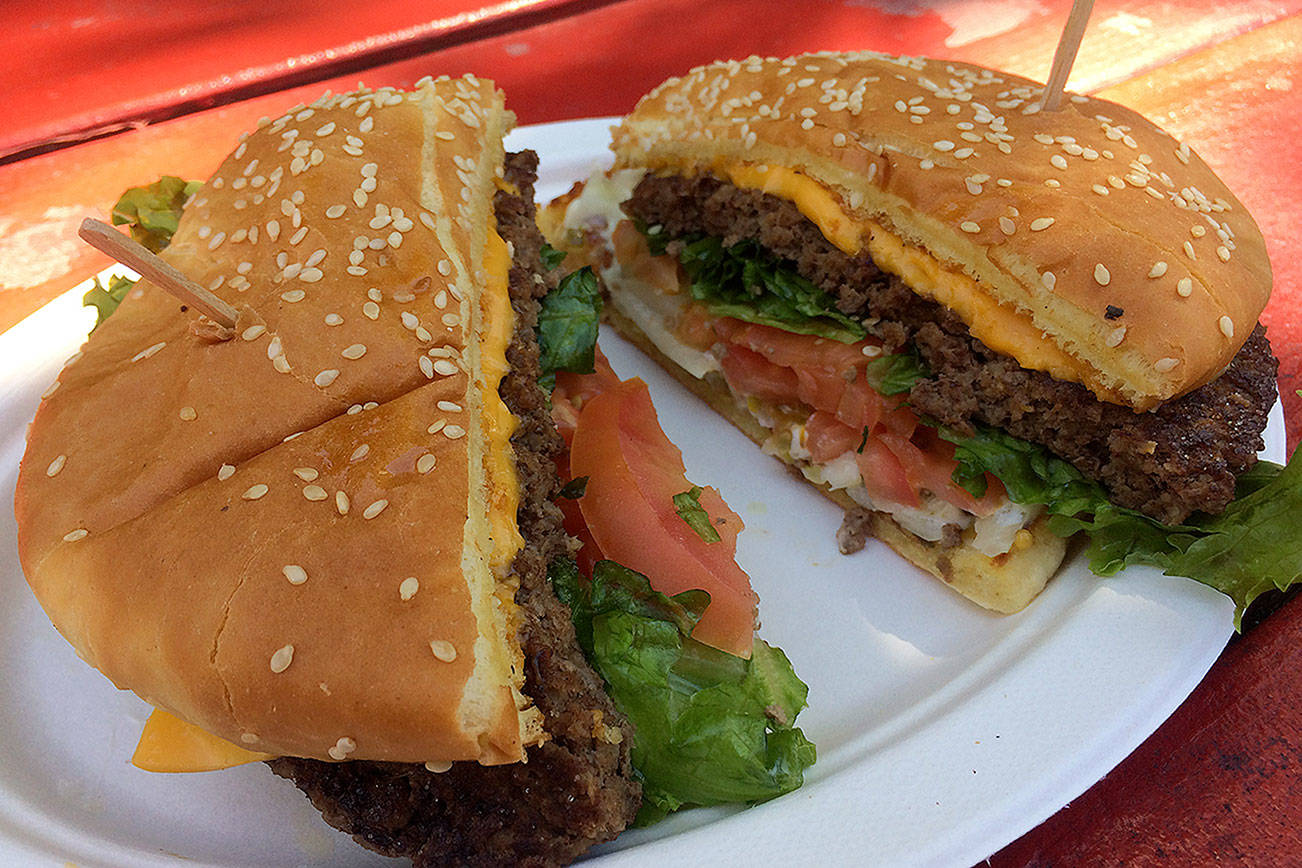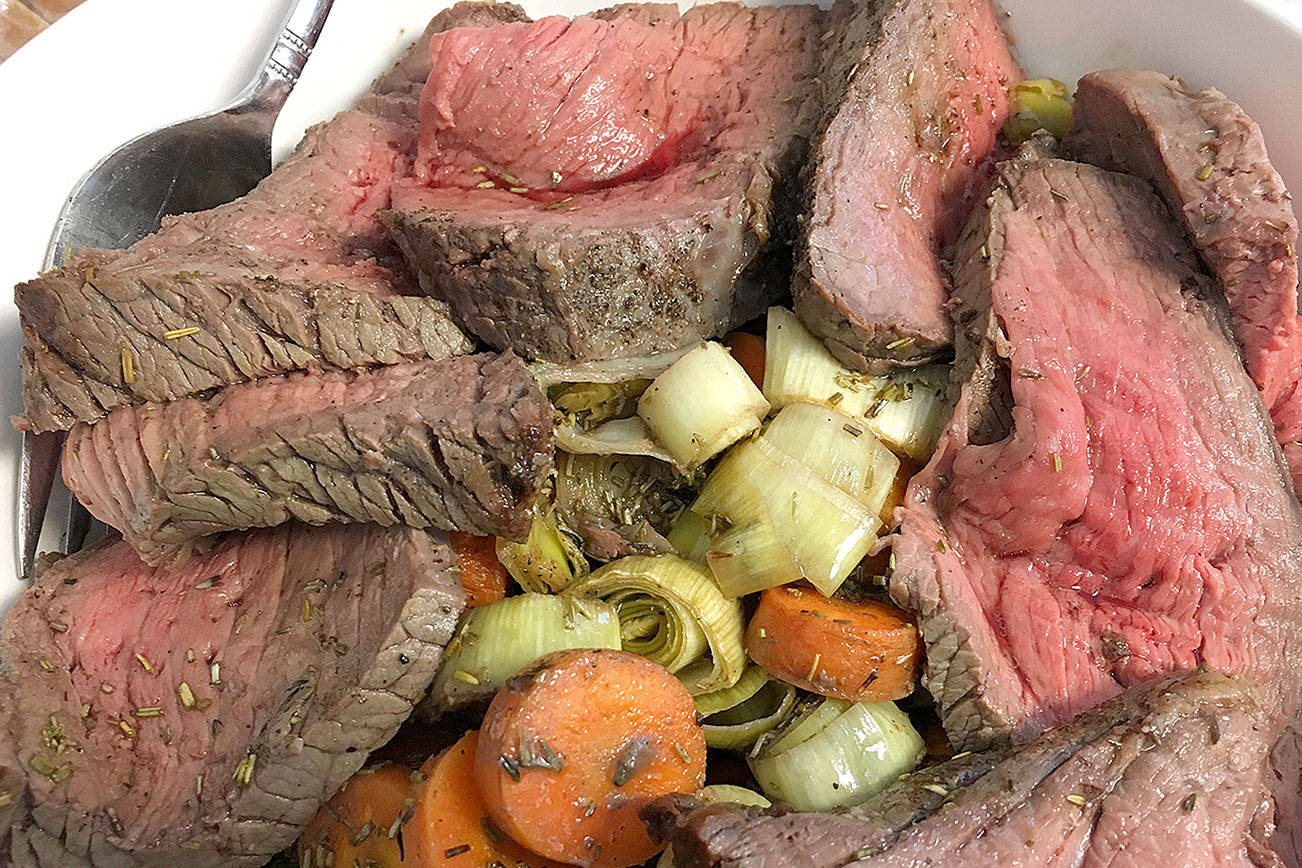If the newspaper saw is true that three of anything makes a trend, then Indonesian restaurants in Seattle are hot, hot, hot. Last year Indo Cafe in Northgate got new owners who spiffed up their place. Then Padi Indonesian on the Ave quietly opened six months ago. Now Julia’s Indonesian Kitchen in Roosevelt, which Julia Suparman and her daughter-in-law, Yusi Sasmitra, started as a catering operation last September, has begun serving the public. I’ve liked each place better than the last.
Everything about Julia’s is built on the scale of cute: a tiny Craftsman house on 65th, a slim dining room wrapped around a central hearth whose mantel displays elaborate Javanese puppets. The restaurant is decorated inexpensively but well, painted a muted green and set with black wood chairs and small tables. Batik curtains with intricate designs separate the kitchen doorway and line the windows. Sasmitra works the front of the room, speaking softly and brandishing a big smile.
Suparman’s husband, Rudy Tanumihardja, has been assigned bussing duties while his wife runs the kitchen. At one point, he came over to our table to pour water and joined the conversation, which was about hiding from neighbors who drop by too often. “In Indonesia, it’s very neighborly,” he said wistfully. “You go over to your neighbor’s to borrow a cup of sugar and then stay to talk for two hours.” Julia and Rudy’s kids brought their parents to the States to be closer to the grandchildren, and now he only gets to return home to Singapore, where the family lived for three decades, on “vacation.”
The place was so fracking cute that even when our water glasses were being filled every three minutes by a bored Tanumihardja or when everyone disappeared into the kitchen for 20 minutes, leaving all of us in the dining room waiting for something or other, I had to poke myself in the leg with a knife to say anything bad about the place. Ack…critical powers neutralized by the force of nice…gark….
Julia’s food is built around sweet, rounded flavors that are easy to like if not necessarily charismatic. As our grandfather-busser told us, it’s partly a regional style: “The Javanese food [we cook here] is slightly sweeter and less spicy than in other areas,” Tanumihardja said. Take, for instance, risoles, a Dutch-Indonesian dish (history reminder: The Dutch occupied Indonesia for more than 300 years). The risoles, which resemble flattened egg rolls, are soft crepes rolled around chicken and vegetables suspended in a slightly sweet white sauce—one friend compared it to a deep-fried pot pie.
The bakmi ayam pedas—a bowl of almost firm, crinkly wheat noodles topped with ground chicken, black mushrooms, and fried shallots sautéed with sweet soy sauce—also comes across as sweet and pleasant, with barely enough chiles to prickle the tongue and a mild undercurrent of funky shrimp paste. “White food” is generally synonymous with “bland,” but Julia’s white curry of vegetables is actually entrancing. A mix of things like baby corn and green beans is coated in a thick white coconut-milk sauce seasoned with cinnamon, ginger, and some other unidentifiable spice that keeps slipping away just as I’m about to identify it. Suparman’s spicing is so subtle and balanced that I get hit with the same just-missed sensation over and over again.
The white curry is part of the mixed-rice plates that dominate the lunch menu, each item given mysterious codes like D2 or N5. (Each time I called out a code, I expected Sasmitra to tell me we’d sunk her battleship.) If you want a noodle dish or one of three house specials like gado-gado, the ordering is straightforward: one code, one dish. But to get a chicken curry, say, you have to order one of two different kinds of rice plates—one simply with rice, the other a “mini rijsttafel,” costing a whole dollar more. The latter comes arranged on green plastic plates shaped like sections of banana leaf. Around a mound of rice with fried shallots are: the main dish, the white curry, a soggy corn fritter, and a few raw vegetables. (If you come for dinner—which is only served Friday through Sunday, mind you—you can order a full rijsttafel, the colonial Dutch meal in which the cooks will cover the table with small dishes. It serves four.)
Some of the main dishes on the rice plates were ho-hum—chicken breast meat in a sauce flavored by what tasted like coconut milk and packaged curry powder, or cubes of tofu and tempeh in a sweet soy sauce that didn’t inspire anyone to finish it off. Others, like the beef rendang, stewed so long in a mix of coconut milk and spices that the liquid reduced into a thick paste, were as good as the white curry.
Perhaps the strangest section of the menu consists of the drink-slash-desserts, which look and taste like liquid versions of kids’ breakfast cereals. My es doger had yellow chunks (jackfruit), white chunks (coconut), and several colors of clear chunks (agar agar and palm seeds) floating in a glass of ice and milk. At the bottom of the glass was a hot-pink layer. A straw stuck into the center dredged up a thick, rosewater-scented syrup; an hour after stirring the drink around, it still hadn’t incorporated into the milk, so I disturbed it as little as possible.
If it crunches, Julia’s is all over it.
Baskets of bagged kerupak, or crackers, sit below the cash register at the entryway: fish crackers looking like braided circles of dried ramen noodles, gray cassava chips, and puffy shrimp kerupak resembling napkins frozen midwave. The latter go with the gado-gado betawi, itself a bowl of crunchy raw vegetables covered in an addictive peanut sauce. The kerupak can also be used to scoop up a curry or serve as a post-meal snack.
But the crunchy dish that brings down the house is Julia’s house specialty, ayam goreng kremes. She slowly cooks the chicken in a broth spiced with things like lemongrass, galangal, and candlenut, then coats it with a batter that goes all crackly and golden in the deep-fryer. The meat falls off the bone the moment you crunch through it. But the fried chicken is upstaged by a shower of extra “crispy bits”— that’s their official title on the menu—that Suparman makes by stirring flour into a fatty chicken stock, then gently spooning the batter into hot oil, so that it fries into meaty, crunchy, lacy flakes. I watched a group of young guys split a plate of ayam goreng kremes, devouring the meat in the time it took me to do a double-take, then slowly savoring the bits, pressing them into clumps of rice with their fingers and dipping the clumps in sambal terasi.
The sambal terasi is the grand unified theory of Julia’s food, the condiment that brings together everything—the rijsttafel plates, the chicken, the noodles. Indonesia’s repertoire includes dozens of sambals featuring everything from green chiles to anchovies, but Julia seasons her house sambal, a syrupy garlic and red-chile jam, with terasi, or fermented shrimp paste. The effect of the shrimp paste on the sambal is like a dollop of olive paint stirred into a can of bright yellow: Even as the terasi’s aroma almost disappears into the jam, it contributes a pungent, almost unappealing background note that transforms the sweet-spicy sambal into something deeper and more satisfying. It had the same effect on all that it touched.






